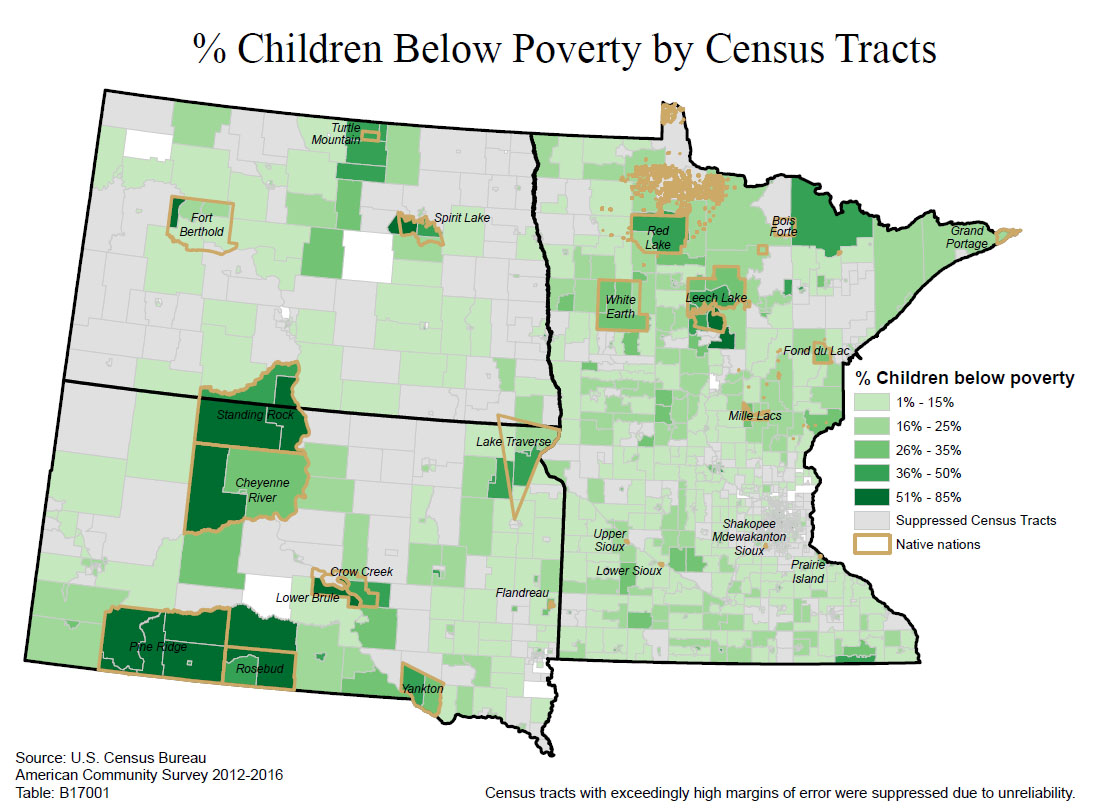A new report from First Nations Development Institute lists us as the 7th biggest foundation funder of Native issues in the US.
On one hand, it is exciting to be recognized as one of the top funders of Native American organizations and causes. We are proud of the work we are doing with Native partners around the region and love having that work highlighted and celebrated.
On the other hand, we are really small compared to most of the other foundations on the list. So being ranked so high is actually more of a indication that giving to Native issues is just not a priority to most other foundations.
I believe a lot of funders are missing a great opportunity for impact.
The need in most of our Native communities is profound. Poverty rates on the reservations in our Bush Foundation region range from 21% to 51%. Wilder Research created this map for us that shows childhood poverty rates in our region with an overlay of the boundaries of reservations. The correlation is striking.

We talk a lot in philanthropy about disparities associated with race and disparities associated with place. Many of our tribal communities face both. And those challenges are compounded by a fraught history of ever-changing relations with federal, state and local governments. (In my job, I have heard racism and resentment expressed toward Native Americans that has sometimes left me stammering in surprise.)
There are certainly reasons why giving to tribal communities can be challenging for foundations — like a lack of trusting relationships and/or cultural misunderstanding and/or geographic isolation. But there are easy ways to draft behind those foundations who have overcome those challenges and are working in good partnership with Native communities.
Our colleagues at Northwest Area Foundation (#4 on the top funder list) have a commitment of investing 40% of their grant dollars in Native-led organizations, across their program areas. This terrific recent blog post shares some of the lessons they have learned and their website includes profiles of fabulous organizations like Four Bands Community Fund, First Peoples Fund, and Thunder Valley Community Development Corporation. (All of which have also won our Bush Prize.) NWAF has been particularly focused on supporting and promoting Native Community Development Financial Institutions and there is a section of their website that provides guidance on how others can invest in and through CDFIs. We drafted behind NWAF’s good work in a recent $1 million loan we made to First Nations Oweesta Institute.
Like NWAF, we are hoping we can be a resource to other funders interested in making a difference on Native issues. Toward that end, we recently published a report on our giving to Native people and institutions across all our program areas. We highlight some of our amazing partners like the Lakota Language and Cultural Institute, the Native Governance Center, and the Tiwahe Foundation.
Philanthropic impact comes not just from addressing a profound need. It comes from investing in extraordinary people and institutions to address that need. It comes from investing in big ideas for change. We see extraordinary people and institutions with big ideas throughout Indian Country.
We hope our relationships and our grantmaking experience can be useful to others. That feels uncomfortably presumptuous to declare. But we’re declaring it because we believe being an influencer on Native issues within philanthropy is one of the highest-impact ambitions we can have.
-Jen